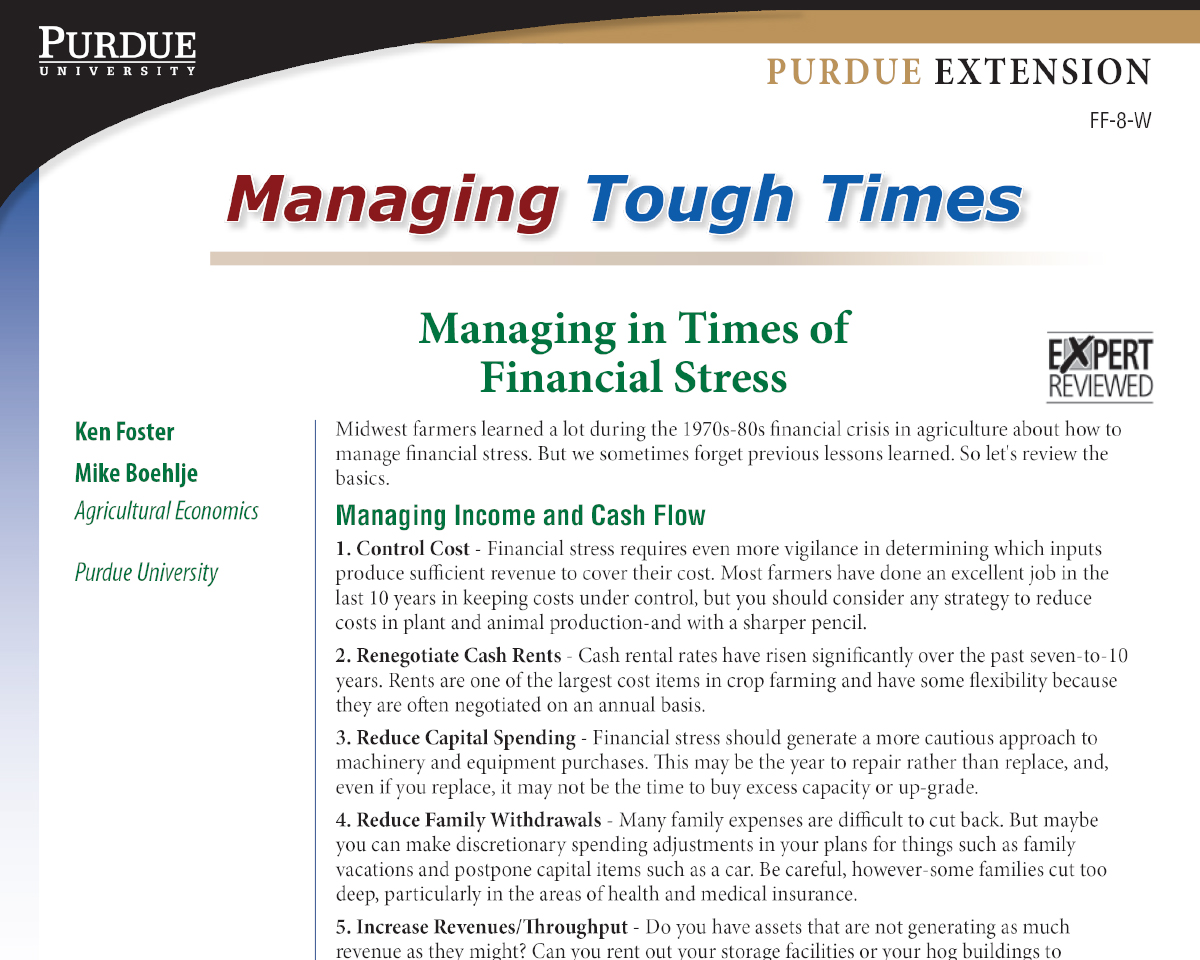January 12, 2008
Managing in Times of Financial Stress
by Ken Foster and Mike Boehlje
Midwest farmers learned a lot during the 1970s-80s financial crisis in agriculture about how to manage financial stress. But we sometimes forget previous lessons learned. So let’s review the basics.
Managing Income and Cash Flow
- Control Cost – Financial stress requires even more vigilance in determining which inputs produce sufficient revenue to cover their cost. Most farmers have done an excellent job in the last 10 years in keeping costs under control, but you should consider any strategy to reduce costs in plant and animal production-and with a sharper pencil.
- Renegotiate Cash Rents – Cash rental rates have risen significantly over the past seven-to-10 years. Rents are one of the largest cost items in crop farming and have some flexibility because they are often negotiated on an annual basis.
- Reduce Capital Spending – Financial stress should generate a more cautious approach to machinery and equipment purchases. This may be the year to repair rather than replace, and, even if you replace, it may not be the time to buy excess capacity or up-grade.
- Reduce Family Withdrawals – Many family expenses are difficult to cut back. But maybe you can make discretionary spending adjustments in your plans for things such as family vacations and postpone capital items such as a car. Be careful, however-some families cut too deep, particularly in the areas of health and medical insurance.
- Increase Revenues/Throughput – Do you have assets that are not generating as much revenue as they might? Can you rent out your storage facilities or your hog buildings to generate revenue? Under-utilized assets are particularly costly in times of financial stress.
- Increase Non-Farm Income – One way to bridge the gap in financially stressful time is to obtain income from non-farm sources. You may not want an off-farm job, but you should certainly investigate the option.
Managing Liabilities
- Extend Loan Terms – A typical adjustment to reduce cash flow pressures is negotiating longer repayment terms. Longer terms to repay will often reduce cash flow pressures, but remember that the debt must still be serviced and that this strategy does nothing to reduce cost or increase income. Extending debt servicing terms in many cases is a mechanism to “buy time” to make more fundamental changes in the business.
- Reamortize Carry-Over – A number of farmers will be unable to repay their operating loan in years of financial stress and consequently will incur carryover debt. One way to manage this carryover is to convert it into a longer term loan – say five years – and set up a payment schedule to systematically reduce it over time.
- Pay Interest Only – When a loan is well secured and the cash flow shortage is assumed to be temporary, the lender may accept an interest-only payment as an alternative to the full principal and interest payment required by the amortization schedule.
- Increase Collateral – This strategy again does little to relieve the root causes of financial stress. It does give the lender a stronger financial position in case of default down the road, so it may relieve current intense financial pressure.
- Acquire Guarantees or Contracts – Like increasing collateral, this strategy increases the comfort level of the lender and consequently should increase his willingness to extend repayment terms or reamoritize collateral.
- Reduce Debt – Certainly one way to reduce financial stress is to pay off some of the debt and reduce the debt servicing requirements. The funds might come from non-farm earnings, other family members in the form of a gift or personal loan with attractive terms, or the sale of farm business assets.
- Refinance – If interest rates have declined. It might be possible to refinance some loans and reduce interest expenses. You need to compare the cost of refinancing with the savings in interest. This might be a good time to move variable rate loans to fixed rate loans in order to reduce the risk of any future interest rate increase.
Managing Assets
- Liquidate Cash/Investments and Reduce Debt – This strategy involves the use of cash and financial reserves that have been maintained in the business to reduce the debt load. But most farm businesses do not maintain substantial cash or liquid asset positions, so this strategy is typically not a realistic option.
- Sell Inventories and Pay Down Debt – Some farms may have accumulated substantial inventories. Although selling inventories when prices are going up may not seem an attractive alternative, it may be a reasonable option, particularly if the stress is severe and in light of the storage and other carrying costs associated with most inventories. However, the entire proceeds received from liquidating raised products will often be taxed at ordinary income tax rates unless expenses or deductions are available elsewhere to offset this taxable income.
- Sell Capital Assets and Reduce Debt – Selling capital assets such as land, machinery, and equipment is possibly a good strategy given the current strong value for these assets. But remember, this strategy also will likely reduce the long-term income generating capacity of the business. Again, you should consider tax consequences of such a sale.
Conclusion
The best strategy is to resolve financial stress problems before they become severe. One of the most important rules of managing in times of financial stress is summed up in the simple but powerful phrase-early recognition, early resolution.

TAGS:
TEAM LINKS:
RELATED RESOURCES
UPCOMING EVENTS
We are taking a short break, but please plan to join us at one of our future programs that is a little farther in the future.





